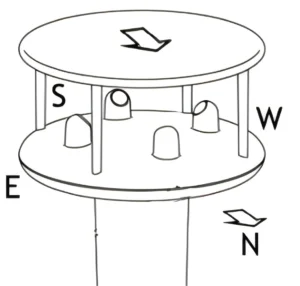ultrasonic anemometers:
An ultrasonic wind sensor measures how fast the wind blows and which way it is going. It works on the idea that wind affects the speed of ultrasonic waves in the air. It has many benefits. These features include:
– High precision
– Quick response
– No moving parts
– A wide accurate measurements range
– Strong adaptability to the environment
It is used in many fields such as weather, environmental monitoring, energy, construction, transportation, and aerospace. It plays an important role in giving accurate wind data for different uses.
ultrasonic wind sensor working principle
Working principle:
It mainly measures wind speed by timing how long ultrasonic waves take to move through the air. The sensor typically has two sets of ultrasonic probes.
These probes are placed so they face each other. One probe in each pair sends out ultrasonic waves. The other probe acts as the receiver.

Feature
High accuracy:
It measures wind speed more accurately than older tools, like the wind cup anemometer. This is especially true when the wind speed is low.
Fast response speed:
It can quickly notice changes in wind speed. It also tracks these changes in real time. This makes it great for situations that need a fast response to wind speed changes.
No mechanical wear:
It does not use moving parts to measure wind speed. This means it does not have wear issues like the wind cup anemometer. This means it lasts longer and costs less to maintain.
Ability to measure wind direction simultaneously:
We can find the wind direction and measure wind speed by using different probes together.
CODA Ultrasonic wind speed and direction sensor
CDF-21A Ultrasonic wind speed and direction:
Range 0-60m/s.
Resolution:0.01m/s.
Automatic heating can be customized.
RS232/RS485(Modbus/NMEA-0183),4-20mA/0-5V(only for wind speed & direction) SDI-12 optional.
CDF-22A Mini Ultrasonic wind speed and direction:
Range 0-40m/s.
Resolution:0.1m/s.
Air pressure elements can be customized.
RS485(Modbus)
Extreme Wind Speed :60m/s
CDF-22B Mini Ultrasonic wind speed and direction:
Range 0-40m/s.
Resolution:0.01m/s.
Sampling Frequency:10HZ
RS485(Modbus)
Extreme Wind Speed :60m/s
Application:
bridge monitoring
Monitoring environment:
The changing ocean environment and climate often put a big cross-sea bridge at risk from strong winds. To keep the bridge safe and ensure safe driving, we need to check the wind speed and wind direction. This should be done correctly and in real-time at the top of the bridge.
Install position:
Place the ultrasonic wind speed sensor at the top of the main tower on the bridge. “Also, put it in key places on the bridge girder.” These locations can collect wind data at different heights and key parts of the bridge.
Data transmission:
We send the collected data through a wired network, like fiber optic, or a wireless network, like 4G or 5G. This data goes to a server in the bridge management center.
Park monitoring
Monitoring environment:
The large science and technology park covers a wide area. It has many tall buildings, green areas, and places to have fun. Some park facilities are affected by the wind. These include tall billboards, glass buildings, and small weather stations.
To keep these facilities and people safe during windy weather, park management decided to install ultrasonic anemometers wind. They also added alarm systems. These systems help monitor wind conditions in the park and provide early warnings.
In line with the wind resistance plans for different areas in the park, we have set up a system of alarms. For example, in work areas, if the wind speed hits 10 meters per second, the system will send a first alert.
This alert will let everyone in the park know about the windy conditions. Please avoid outdoor activities. If the wind speed goes over 15 meters per second, a second-level warning will be issued.
System composition:
Each ultrasonic anemometer connects to a monitoring center server through a wired network on campus. The monitoring center has special software for data collection and an alarm system.
This setup allows it to receive, process, and show wind speed and direction data from many sensors in real-time. It can also send alarm notifications based on set alarm thresholds.
Marine monitoring
Monitoring environment:
The safe navigation of ships is very important. The sea environment is complicated and can change fast. Wind conditions have a big impact on how ships move. To better handle sea wind and improve safety, the ship has installed a new ultrasonic wind meter system.
Installation Position: We install the ultrasonic anemometer on the top of the ship’s mast. This spot helps reduce interference from the ship’s structure. It allows us to get the most accurate data on sea wind speed and direction.
System composition:The ultrasonic wind speed sensors connect to the ship’s main navigation computer. The sensors send real-time wind speed and direction data to the Marine computer as digital signals.
Conclusion
As sensor technology improves, ultrasonic wind speed sensors will become more accurate and stable. High-precision timing chips and better signal processing algorithms help with this.
These sensors can measure wind speed and direction better. This will meet the precise data needs for weather forecasting and scientific research.